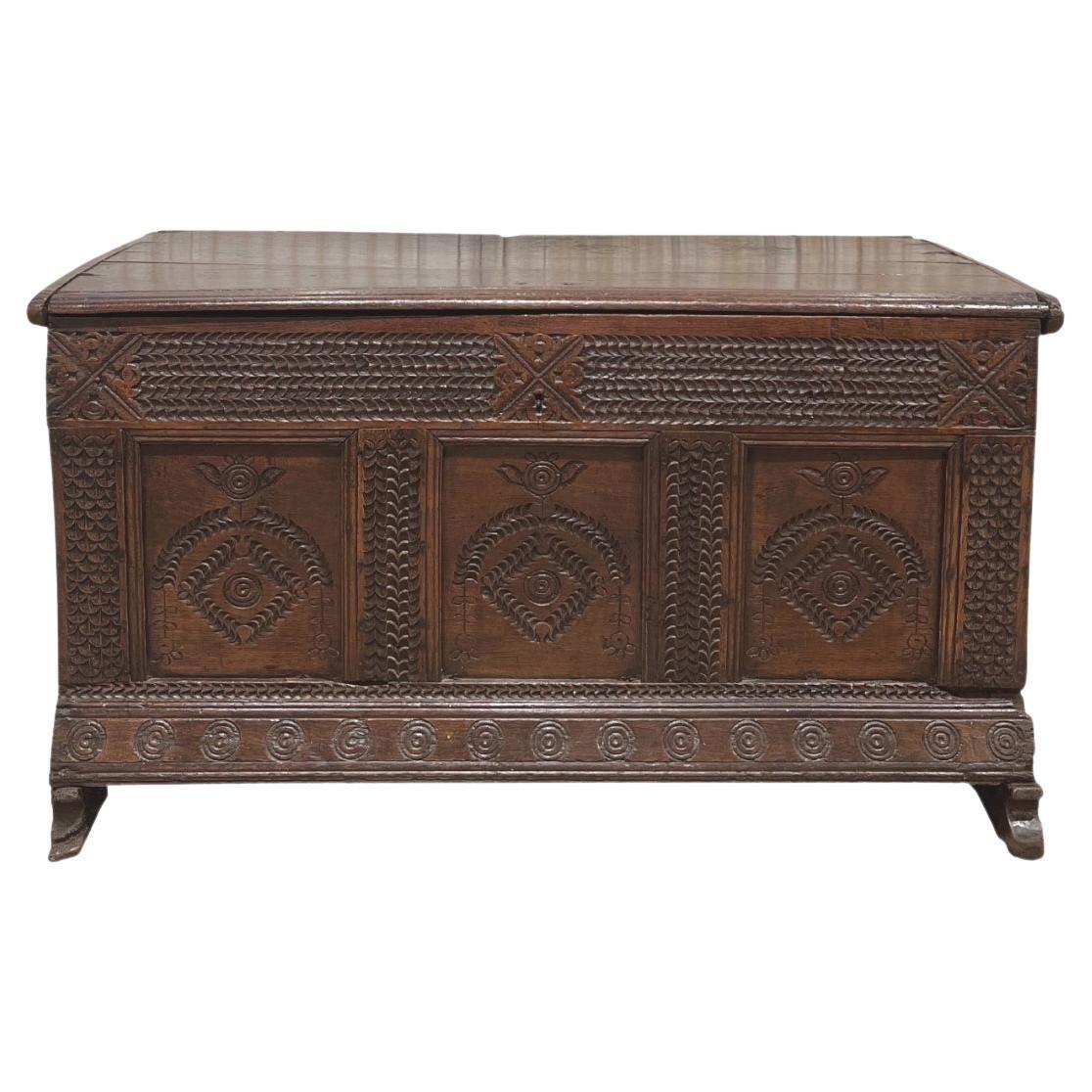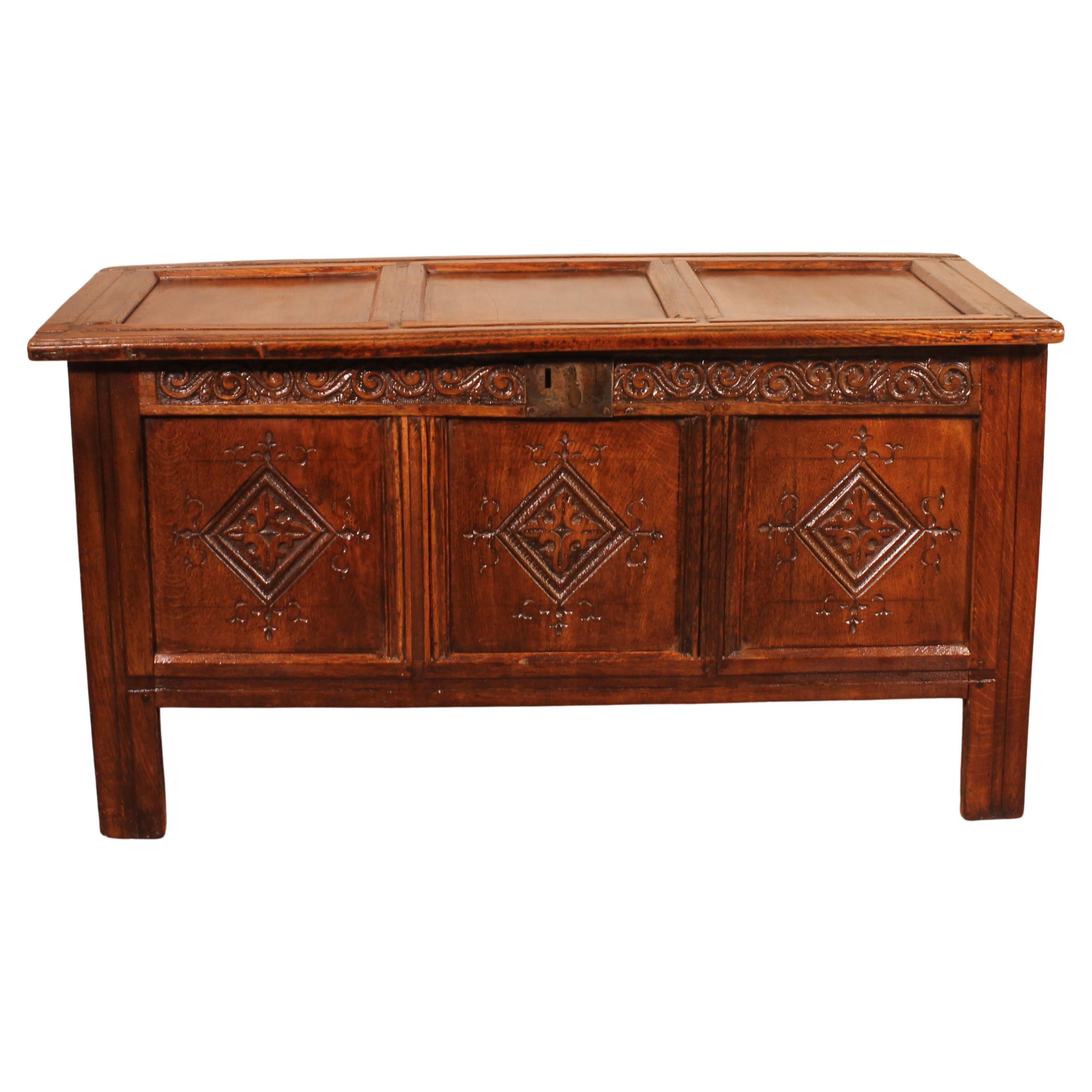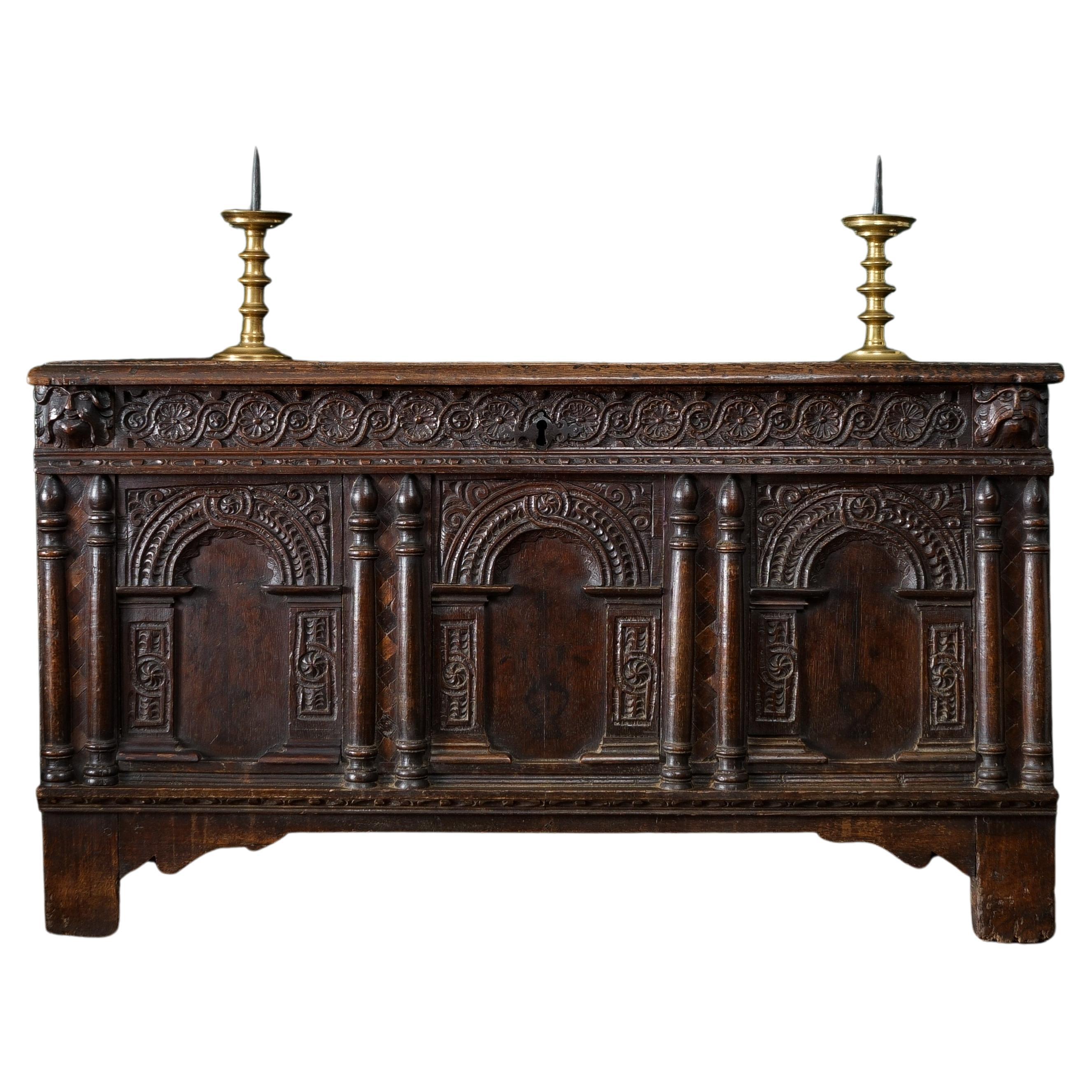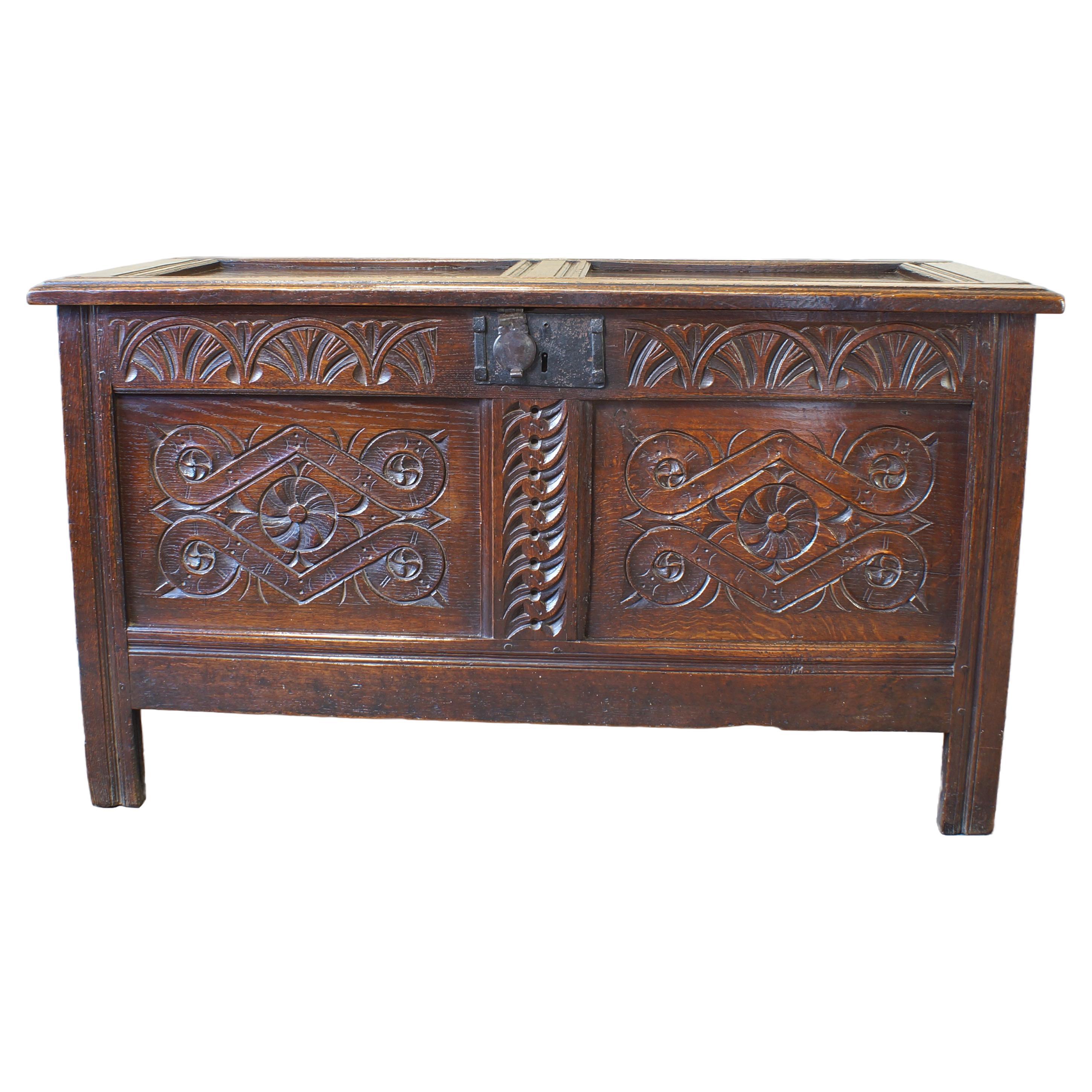Items Similar to 17th Century English Carved Oak Dowry Chest
Want more images or videos?
Request additional images or videos from the seller
1 of 21
17th Century English Carved Oak Dowry Chest
About the Item
Presenting an absolutely gorgeous and historic 17th century English carved oak dowry chest.
Made of solid oak in England, circa 1600-1650.
This piece has all the classic signs of genuine age and 17th century English craftsmanship.
The carvings to the front of the chest are simply stunning. Most definitely in the manner and style of Jacobean carving of that period.
The gothic style pillars in particular were classic elements of Jacobean carving.
The front contains 2 large carved panels with profusely carved scrolling floral bouquets. On each pillar there is carved gothic shaped arch which id replicated in the central pillar. The top panels has a series of 5 florettes across the top with another below the escutcheon. The base panel has a series of carved geometric shaped links. On either side of the chest are the 2 original iron handles with scroll ends.
The piece has had some restoration work done to it, over it’s 400 year history, as one would expect.
The lid or top is an early 20th century replacement, but the restorer has used beautiful solid oak planks, with a patina that beautifully matches the base.
The feet have had 'historic' restorative work performed, as there is clear evidence of petrification of the original feet which would have occurred naturally over the Centuries from standing on stone floors and often in standing water from mopping.
This also assists with age verification of the piece.
The hinges for the top are 20th century replacements as is the front escutcheon, but again the restorer has used iron hinges and an escutcheon to attempt to stay as close to the original as possible.
It is missing it’s original lock. The interior of the chest is as it was made, simple and with real evidence of natural aging.
To large to be a blanket chest, this was most likely a dowry or silver chest.
Gorgeous natural golden oak patina!
The Jacobean era was the period in English and Scottish history that coincides with the reign of James VI of Scotland who also inherited the crown of England in 1603 as James I. The Jacobean era succeeds the Elizabethan era and precedes the Caroline era. The term “Jacobean” is often used for the distinctive styles of Jacobean architecture, visual arts, decorative arts, and literature which characterized that period.
The practical if not formal unification of England and Scotland under one ruler was an important shift of order for both nations, and would shape their existence to the present day. Another development of crucial significance was the foundation of the first British colonies on the North American continent, at Jamestown, Virginia in 1607, in Newfoundland in 1610, and at Plymouth Colony in Massachusetts in 1620, which laid the foundation for future British settlement and the eventual formation of both Canada and the United States of America. In 1609 the Parliament of Scotland began the Plantation of Ulster.
A notable event of James’ reign occurred on 5 November 1605. On that date, a group of English Catholics (including Guy Fawkes) attempted to assassinate the King and destroy Parliament in the Palace of Westminster. However, the Gunpowder Plot was exposed and prevented, and the convicted plotters were hanged, drawn, and quartered.
The fine arts were dominated by foreign talent in the Jacobean era, as was true of the Tudor and Stuart periods in general. Daniel Mytens was the most prominent portrait painter during the reign of James, as Anthony van Dyck would be under the coming reign of his son. Yet the slow development of a native school of painting, which had made progress in the previous reign, continued under James, producing figures like Robert Peake the Elder (died 1619), William Larkin (fl. 1609–19), and Sir Nathaniel Bacon (1585–1627). Some would also claim, as part of this trend, Cornelius Johnson, or Cornelis Janssens van Ceulen (1593–1661), born and trained in London and active through the first two Stuart reigns.
The decorative arts – furniture, for example – became increasingly rich in color, detail, and design. Materials from other parts of the world, like mother-of-pearl, were now available by worldwide trade and were used as decoration. Even familiar materials, such as wood and silver, were worked more deeply in intricate and intensely three-dimensional designs.
Architecture in the Jacobean era was a continuation of the Elizabethan style with increasing emphasis on classical elements like columns. European influences include France, Flanders, and Italy. Inigo Jones may be the most famous English architect of this period, with lasting contributions to classical public building style; some of his works include the Banqueting House in the Palace of Whitehall. St Paul’s Cathedral designed by Sir Christopher Wren in London. See also: Jacobean architecture.
In the domain of customs, manners, and everyday life, the Jacobean era saw a distinctly religious tone. Virginia tobacco became popular. James I published his A Counterblaste to Tobacco in 1604, but the book had no discernible effect; by 1612, London had 7,000 tobacconists and smoking houses. The Virginia colony survived because the English acquired the nicotine habit.
- Dimensions:Height: 32.25 in (81.92 cm)Width: 57.25 in (145.42 cm)Depth: 23.5 in (59.69 cm)
- Style:Jacobean (Of the Period)
- Materials and Techniques:
- Place of Origin:
- Period:Early 17th Century
- Date of Manufacture:1600-1650
- Condition:Repaired: Se full listing for details of restoration and repairs. Wear consistent with age and use. Minor losses. Minor structural damages. Minor fading. Despite repairs this piece is in very good condition for it's age.
- Seller Location:Dallas, TX
- Reference Number:1stDibs: LU3978120896932
About the Seller
4.9
Platinum Seller
These expertly vetted sellers are 1stDibs' most experienced sellers and are rated highest by our customers.
Established in 2015
1stDibs seller since 2018
348 sales on 1stDibs
Typical response time: <1 hour
- ShippingRetrieving quote...Ships From: Dallas, TX
- Return PolicyA return for this item may be initiated within 7 days of delivery.
More From This SellerView All
- Rare Late Medieval 16th Century German Wrought Iron Oak Chest or StollentruheLocated in Dallas, TXWe have the pleasure to present a rare late medieval 16th century German wrought iron oak chest or Stollentruhe. This is an early 16th century, ci...Category
Antique 16th Century German Gothic Blanket Chests
MaterialsWrought Iron
- 19C English Naval Captain's Sea ChestLocated in Dallas, TXPRESENTING a GORGEOUS 19C English Naval Captain’s Sea Chest. Made in Britain, probably England, circa 1851-55. Early Victorian Era. Made of...Category
Antique Mid-19th Century English Early Victorian Blanket Chests
MaterialsOak
- 18C Irish George II Mahogany Silver Chest on Exceptional Carved StandLocated in Dallas, TXPRESENTING AN ‘ABOLUTELY STUNNING’ PIECE OF IRISH FURNITURE HISTORY, namely, an 18C Irish George II Mahogany Silver Chest on the most amazing and EXCEPTIONAL Carved Stand. Made circa 1745, by an obviously ‘top quality’ Irish Georgian furniture...Category
Antique Mid-18th Century Irish George II Blanket Chests
MaterialsMahogany
- 19th Century French Provincial Highly Carved Oak Hunt BookcaseLocated in Dallas, TXPRESENTING AN ABSOLUTELY GORGEOUS AND IMPOSING Early 19C French Provincial Highly Carved Oak Bookcase. French Provincial Oak Bookcase from circa 1840. Heavily carved, this style is often referred to as being in "Hunt Style", from Northern France and often incorrectly, described as Flemish. Pelmet heavily carved with Armorial Crest. The upper section consists of a 2 door glass fronted Bookcase and has Gorgeous barley twist columns to the sides, with 3 interior shelves. The Base has two doors each with exquisite carvings, one with hanging game birds...Category
Antique Mid-19th Century French French Provincial Bookcases
MaterialsOak
- 18th Century George II Miniature Campaign Bureau Chest on Later Chest StandLocated in Dallas, TXPRESENTING A GORGEOUS and beautifully proportioned Mid-18th Century George II Miniature Campaign Bureau Chest on later Chest/Stand. Mid-18th century, made in Britain, circa 1760-1770. The bureau chest sits on a later stand/chest, that we estimate is late 19th century, circa 1860-1880. It is also British. We believe that the primary wood in this piece is either Elm or Sycamore with mahogany elements. Classic Campaign style miniature Bureau Chest, with its ORIGINAL George II brass hardware, including handles on the sides for easy carriage, which is what proves to us, that this chest was made for campaign purposes. The brasses are GORGEOUS and are classically George II in style, design and construction. The quality, thickness and patina to the brasses, is what ‘initially’ tells us, that this is a ‘period’ piece and not a reproduction. Likewise, the dovetailing detail to the drawers, tells us that this was a hand crafted piece and certainly NOT machine made. The secondary woods appear to be a combination of oak and pine, exactly as one would expect. The central keyhole escutcheons are FANTASTIC and are in the form of a pair of opposing ‘lyres’. We have never seen anything like them! Beautiful natural patina! The ‘brasses’ look like they have been polished a ‘little too often and vigorously’, over the piece’s 250+ years history … BUT … the bonus of this cleaning is the creation of a rather appealing, '2 Tone effect’, on the patina of the wood around the brasses. The Bureau has a flat gallery...Category
Antique 18th Century English George II Secretaires
MaterialsBrass
- Outstanding Early 18th Century English George I SecretaryLocated in Dallas, TXPresenting a stunningly gorgeous and outstanding early 18th century English George I Secretary. This is one of the finest old English Secretary’s...Category
Antique Early 18th Century English George I Secretaires
MaterialsMahogany, Satinwood, Walnut
You May Also Like
- Mid-17th Century English Carved Oak Blanket ChestLocated in Alpharetta, GAcirca mid-17th century, England. Antique Charles II Carved Oak Coffer / Chest / Trunk, circa 1670. This beautiful hand-carved oak coffer/chest/trunk is like a little bit of ...Category
Antique Mid-17th Century English Charles II Blanket Chests
MaterialsIron
- 17th Century English Chest in OakLocated in Brussels, BrusselsSuperb English chest from the 17th century in oak. Very beautiful chest which has a superb carved face. Paneled sides. The chest has its original entrance as well as its original ...Category
Antique 17th Century British Renaissance Blanket Chests
MaterialsOak
- Oak Chest From 17th Century 4 PanelsLocated in Brussels, BrusselsSuperb English chest from the 17th century in oak composed of 4 panels rare chest due to its quality of sculpture which is exceptional and its 4 panels since very often 3 panels Ver...Category
Antique 17th Century British Jacobean Blanket Chests
MaterialsOak
- 17th Century, Charles I, Carved & Inlaid Oak Chest, England, Circa 1640Located in Leominster, GBThe triple panelled lid with broad and flat run-moulded rails, the front with three panels, each with stained-black foliage issuing from baluster shaped vases, enclosed within a finely gauge and cable-carved arcade, spaced by applied split columnar-turnings separated by alternating diamond set inlay, below a guilloche flower...Category
Antique 17th Century British Jacobean Blanket Chests
MaterialsOak
- 17th Century English Two Panelled Oak CofferLocated in Skipton, GBAn excellent 17th Century Two Panelled Oak Coffer in good clean original condition, having good colour and patina. The panels are nicely carved with stylized lozenges and the top ra...Category
Antique 1640s English Jacobean Blanket Chests
MaterialsOak
- 17th Century Oak Marriage ChestLocated in Chelmsford, EssexFor sale is a good quality mid 17th century oak marriage chest, having a three panel top with raised and fielded panels to the front, with a carved date of 1744 and the initials H.B....Category
Antique 17th Century Blanket Chests
MaterialsOak





